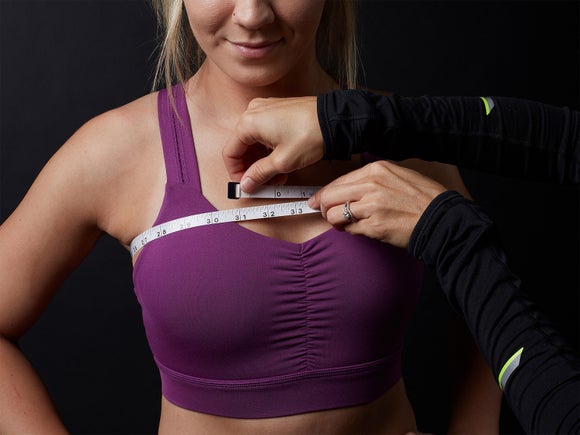How to Find the Right Sports Bra Size
When it Comes to Your Sports Bra, "Size Matters"
Did you know that eight out of ten women wear the wrong size sports bra? That means that most women are not having the positive and comfortable running experience that they deserve. Correct sizing is arguably the most important factor in a sports bra's overall comfort. A bra that is too big will not provide enough support, and a bra that is too small can restrict movement and breathing. Our goal is to change women's sports bra experiences by ensuring that they are in the right size for their individual bodies. Follow these simple steps to learn how to find a sports bra that fits you perfectly.
Step One: Find Your Band Size
So how do you find your size? The first step is to take a few measurements, which you can either do yourself or have someone else do for you. You’ll need a soft tape measurer in order to find your band size and cup size.
We have found that the best way to find your band size is actually to measure above the bust, just below the armpits. This may seem a bit counterintuitive since the band of a bra goes in a completely different place, but it turns out that measuring below the bust can provide incorrect sizing for women with certain shapes of ribcages. The measurement that you take here, across the top of the bust, is your band size.

Step Two: Find Your Cup Size
To find your cup size, take the measurement around the fullest part of the bust. Make sure that the measuring tape is kept level and is not too tight. Round this measurement up to the closest inch and subtract the band size you measured in the first step to find the difference. Use this number to find your cup size by consulting the chart below:
| Difference (bust - band) | Cup Size |
|---|---|
| 1" | A |
| 2" | B |
| 3" | C |
| 4" | D |
| 5" | DD |
| 5.5" | E |
| 6" | F |
Now that you're aware of your measurements, you can use brand sizing charts to find your correct size bra. Be aware that different brands may size their bras slightly differently, so just because you're a certain size in one brand, you won't necessarily be the same size in another brand. Be sure to check each brand's sizing chart just to be sure.

Step Three: Find Your Support Level
Different activities call for different types of bras. Just like you wouldn’t wear that lacy little number on a backpacking trip, you probably won't want to wear your yoga bra while going for a run. This is because different activities create different levels of impact, and a bra that provides sufficient support in lower-impact activities may not provide enough support for a high-impact activity like running. There are three different support levels that sports bras are categorised into:
- High-impact support is necessary for activities involving a great amount of motion, like running and mountain biking
- Medium-impact support is sufficient for activities such as hiking or cross-training on the elliptical
- Low-impact support will keep you covered during activities like yoga and weight lifting
If you’re smaller chested (A/B cup), you won't need as many support features in your bra to provide high-impact support, but if you have a C-cup bust or larger, you'll want more features focused on high-impact support.
There are different sports bra features that are designed to add comfort and the correct level of support for your personal needs. Read about them in our article about how to find the best sports bra style for you.